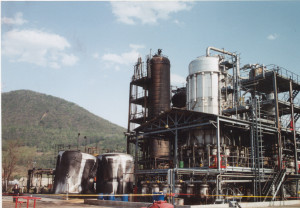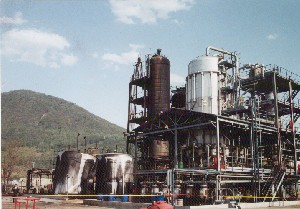An explosion perceived tens of km around and an ensuing fire destroyed 1,000 of the 4,000 m² of a hydrogen peroxide unit (H2O2) located near a series of hydrogen and chlorine tanks. The fire spread into the adjoining sewers, and a nauseating odour permeated the air. A safety perimeter was set up. One employee was killed and 2 others injured; property damage was valued at 483 million francs and 1,000 m³ of fire extinction water containing a solvent polluted the DRAC river after having overflowed from a retention basin that had an insufficient volume.
This accident was due to a defect in the electrical supply card in one of the unit’s control system (digital command control) cabinets. The situation was exacerbated by: difficulties encountered when analysing the situation, an unfortunate attempt of human intervention on the automated system, partial automation of the unit’s emergency shutdown function, non-independent control / security features, insufficient controls over the proper sequencing of installation security combined with several manual steps failing to be carried out by technicians to assist with the night-time shutdown, absence of specific guidelines for ensuring installation safety, and lastly a lack of clarity in the available instructions and procedures.
Due to a breach in the seal of the in situ safety shutoff device (pump discharge check valves, automatic regulation valves), oxygenated water backflow from the extraction column to the oxidiser allowed for the reactive mass to gradually build its concentration of powerful metal agents capable of destabilising H2O2, whose exothermic decomposition was triggered and then accelerated. The resulting oxygen caused a rise in installation pressure and the bursting of a connecting pipe that had not been equipped with a shutoff valve or equivalent protective device. The reactive mass, which was partially emptying from the production machinery, ignited on a hot spot. An organisational deficiency in the area of safety training would lead 3 years after to filing a suit against several plant managers.
Several technical and organisational improvements were introduced at the site: installation of impermeable shutoff devices, protection of pipeline sections capable of undergoing a pressure rise during H2O2 decomposition, enhancement of the command/control system (safety system designed for an emergency shutdown independent of the operating control device, new control room, improved workstation comfort/ergonomics), increased installation retention capacities and sewer protection, redefined scope of site intervention, more efficient information dissemination / training, publication of adapted safety instructions, and completion of safety reports dedicated to the manufacturing, transfer and storage of H2O2.
Download the detailed report in .pdf format (349 Kb)





